
Welcome

EazyCNC
jDraft 2.0



PureJavaComm

PIC CDC ACM

Weather

Ten-Buck Furnace

H8S Bootloader

Camera Calibration

Multitouch

Myford VFD

Fun with HC08

bl08

printf II

Java Goes Native

Densitometer

printf
jApp

Igloo

New Furnace

New Furnace
Part II

Linux 101

H8S/gcc

Quickie

Gas Fired Furnace

Down Memory Lane

Exlibris

Wheel Patterns

Glitches

CHIP-8

eDice

Animato
jDraft

JNA Benchmark

Contact Info
New Furnace - Part II
As I wrote on this page I was not totally pleased with my new furnace, so here is the sequel. If you missed story of the original furnace, see this page first.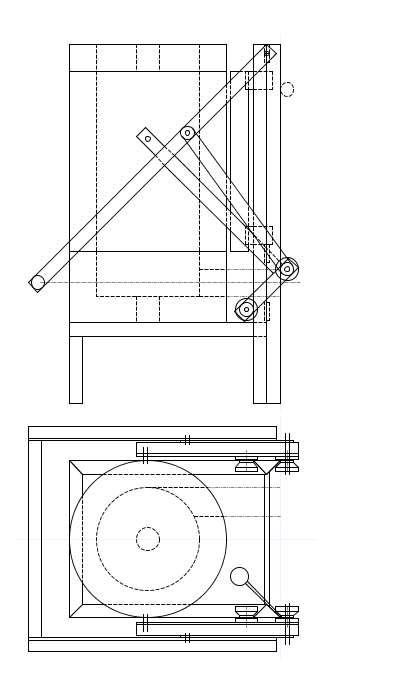 To bring on board those who have not been
following this series daily I've put a drawing of the Gingery design on
which the New Furnace was based. The Gingery design has several good
features:
the lifting body gives safe access to the crucible, the lifting
mechanism is fast to operate, an important
point when casting iron in this scale, the locking mechanism for the
lifting body is inherently safe without
any failing latches, the furnace has a small foot print and overall
dimensions.
To bring on board those who have not been
following this series daily I've put a drawing of the Gingery design on
which the New Furnace was based. The Gingery design has several good
features:
the lifting body gives safe access to the crucible, the lifting
mechanism is fast to operate, an important
point when casting iron in this scale, the locking mechanism for the
lifting body is inherently safe without
any failing latches, the furnace has a small foot print and overall
dimensions.
However I was not totally happy with mine.
The first problem was that the furnace had a tendency to tilt backwards when I lifted the body. This was because the wheels had tendency to stick to the vertical columns. This I attributed to the small wheel base and the unfavourable proportions of the lifting body frame that multiply the force that the weight of the furnace body exert on those wheel. It is also fair to say that my furnace is larger than the original Gingery design.
The second big problem was that when lowering the furnace body the furnace lid would refuse to come down, the telescopic mechanism being totally dysfunctional.
Though I realised that part of the problem was my poor
implementation, and not the design per-se, I set out to
'correct' the 'flaws' in Gingery's design, with the confidence that you
get from total ignorance. And
for that too I blame him ;-) as Gingery is great on 'how' but very
doesn't realy bother with the 'why'.
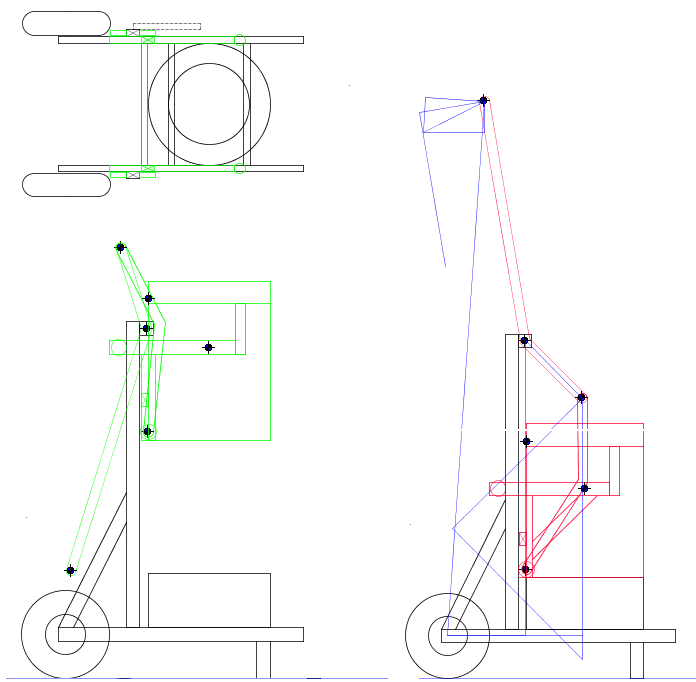 On the left my improved design.
On the left my improved design.
The main improvement is that the lifting body frame/wheel arrangement is the obvious horizontal bar connected to a vertical bar with wheels at both ends. This gives a long wheel base and smaller forces on the wheels. Not the kind of strange arrangement that the original design exhibited. Of course my design necessiated longer vertical columns, but who cares.
The second improvement was to dispence with the telescopic lift mechanism altogether and hinge the lid to the lifting body frame.
And because the furnace was rather heavy I include two wheels at the back so that it could be transported wheel barrow like.
I also reversed the lifting lever desing so that instead of lifting up the lever is pulled back and down. My thinking being that pulling down is better on you back than lifting up. And I figured that it would also be safer to lift from the back.
I kept the fold over-over-itself linkage design as it very
neatly locks the body in when lifted all the way up.
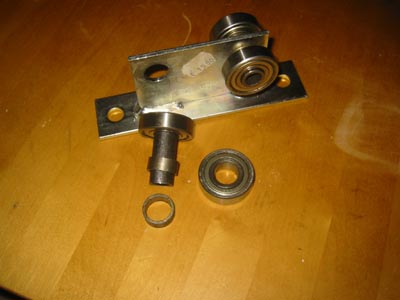 The
lift body rollers wheels came from a barn door (the sliding kind)
hinges that I spotted from a recycling
center (Kuusakoski Oy / Karjaa, a great place to get some real hardware
at bargain prices). These were
much better than the previous ones that I turned from aluminium stock.
The
lift body rollers wheels came from a barn door (the sliding kind)
hinges that I spotted from a recycling
center (Kuusakoski Oy / Karjaa, a great place to get some real hardware
at bargain prices). These were
much better than the previous ones that I turned from aluminium stock.
I just inserted a piece of a steel tube to
reduce the internal diameter, added an M12 bolt and two washers,
and hey presto, a ready made steel roller wheel for less than five
EUROs!
 With my new Power Band Saw (193 EUROs from the
local Hongkong hardware store) ...
With my new Power Band Saw (193 EUROs from the
local Hongkong hardware store) ...
...I soon had cut a few meters of furniture
steel tubing to suitable lengths.
Some solid rubber wheels from Biltema.
Welding is not my strong suit (not with a
transformer and stick anyway)...
... but managed to sputter together a passable
frame.
Top of the vertical columns.
Here is the lifting body. Ok, so I can't weld,
but we went through this already.
Trying the bottom part and the lifting body
together.
Add the swing-aside lid and it does start to
look like it could work.
Ah, what a swinger...
It even stays locked in when lifted up.
And the compulsory reverse angle view (still
don't watch hockey)."Hey, wait a minute, the lift mechanism doesn't
look what you described above?!" Ah well,
the thing is, my plan did not realy work. The pull down lift mechanism,
after consideration (see the blue lines in the drawing) seemed like it
was likely to pull the whole thing
in my lap! And the vertical space required for storage was not good
either.
So at this point I was ready to go back to the
Gingery design, except that NOW I realised that
you realy need the short vertical columns (and the short wheel base I
critisided earlier) that the Gingery desing has, so in the end I had to
resort to this sort of 'Reversed Gingery' mechanism. If only he had
explained why his desing was that way it is...
well, I got to hand it to him, his desing is rather briljant.
So what's the conclusion?
My conclusion is that the original Gingery design is hard to improve on!But there are some points that anyone building this type of furnace might want to consider.
The short columns in Gingery's design are required because otherwise the lifting handle side bars get into the way of the swinging lid. The short columns result in short wheel base for the lifting part. In my first version the wheels that I turned from aluminium did not realy handle that load well, probably because the bearings I used were too small and too loose in their sockects. So my mistake. But I do think that this second approach with square tubing for the columns and large diameter roller bearings without any actual wheels is pertty nice.
The telescopic lift mechanism ala David did not work for me at all. Ok, the tubes I used had some rust in them were probably a bit too tight fit, but still, the load the lid puts on that mechanism is so one sided it is hard to understand how this could work well.
In my design the lid is attached to the lifting body and thus there is no problem with the telescopic mechanism. One thing the telescopic desing does provide is that it lifts the lid clear of the furnace body allowing it to swing aside without scraping the top surface of the furnace body lining and still the weight of the body is supported by the mechanism.
In my desing the lid also clears the furnace body top but the weigth supporting members need to bend a litle as I lift the lid and I need to support the weight of the lid as I move it aside. Not a big deal.
Longer columns will allow for a larger wheel base which definatelly is better and by making the lift bar system wide enough it should be possible to use the original lift-fronm-the-front Gingery mechanism. Note that my furnace is slightly larger and heavier than Gingerys so I definatelly can benefit from having smaller loads on the rollers.
Talking about scaling David's design. The whole design is so compact and well thought out that if you changed the dimension do make sure that every mechanism and link does have room to operate in the scaled up/down design! Voice of experience...
There are some minor points I could mention.
Wheels. The furnace weights close to 100 kg so I can't carry it. Wheels are necessary and four would be better than two. I will probably change that. Because although Gingery seems to work indoors, I definatly will not do foundry work IN my house.
Which leads me to the burner orientation. Gingery is firing from the side which is great giving his workshop configuration, I guess, but it does prevent you from using a two man lifting fork for larger crucibles. So I fire from the back, which also makes the furnace easier to store away for the winter.
Talking of wheels carries me nicely to the next point. If there is too much friction in the lifting mechanism there is not too much margin in the stability of the original furnace desing and the furnace may tilt backwards as you try to lift the body therefore I think the backwheels which move the support point backwards are beneficial too. And the burner fits nicely between the wheel making nice use of that space too.
Gingerys lifting mechanims has no cross members so side ways there is no support. In theory you do not need that as when lowered these is no load and the body is resting on the base part and when lifted the body is resting on the lifting mechanism. But I found it an improvement to add a cross member to the lifting bar.
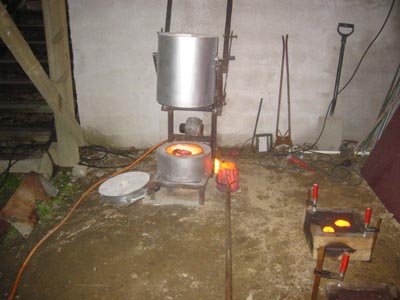 But all is well that ends well - finished up
with some heat resistant paint and fired up with
Mark IV monster burner and I was able to cast some gray iron.
But all is well that ends well - finished up
with some heat resistant paint and fired up with
Mark IV monster burner and I was able to cast some gray iron.
(If you look carefully you see
this picture was actually taken before the lid mechanism and the final
lift mechanism was
fitted.)
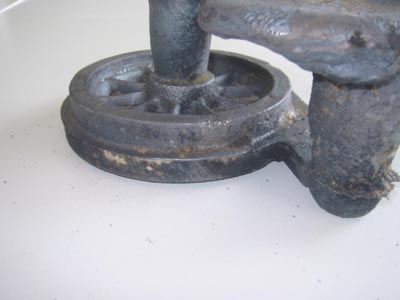 Weather working in my backyard foundry or
writing a web page I always like to finnish up with a succesfull
casting, so here you are!
Weather working in my backyard foundry or
writing a web page I always like to finnish up with a succesfull
casting, so here you are!
cheers, Kusti